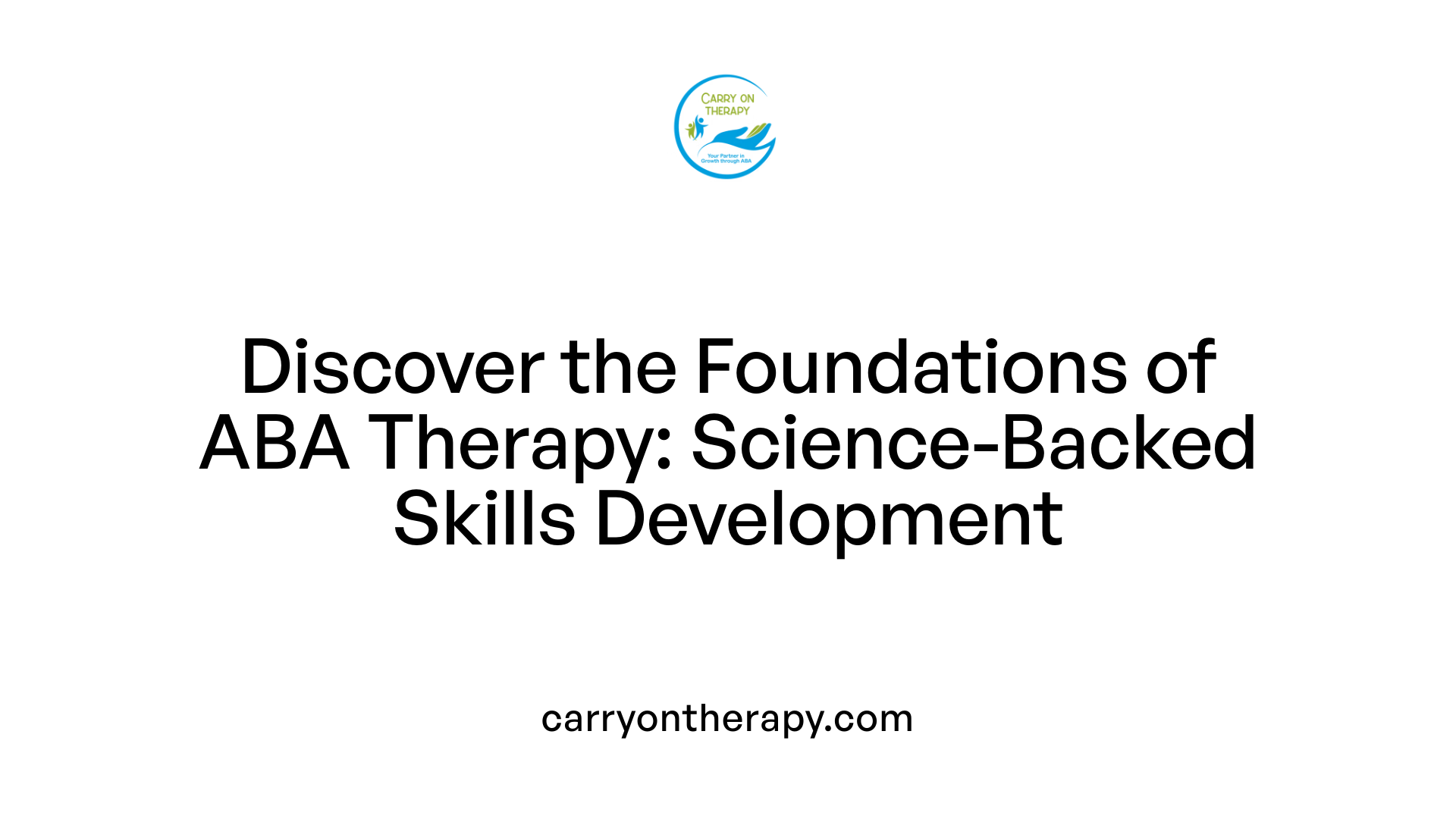Understanding In-Home ABA Therapy
In-home Applied Behavior Analysis (ABA) therapy has emerged as a powerful tool for supporting children with autism spectrum disorder (ASD) and other developmental challenges. By delivering personalized behavior interventions within the familiarity and comfort of one’s home, this approach leverages natural environments to accelerate learning and skill development. Parents are central to its success, acting as active collaborators and reinforcing agents throughout the process. This article explores key elements parents should know about in-home ABA therapy, its benefits, providers, and how it can be tailored to suit each child’s unique needs.
What is Applied Behavior Analysis (ABA) Therapy?

What is Applied Behavior Analysis (ABA) therapy?
Applied Behavior Analysis (ABA) therapy is a scientifically supported treatment grounded in behaviorist principles that focuses on improving specific behaviors and skills. It aims to enhance communication, social interactions, academic abilities, and self-care while reducing challenging behaviors through systematic reinforcement and data-driven decision-making.
What skills does ABA therapy target?
ABA therapy works to improve a wide array of skills including social skills, communication, reading, academic progress, personal hygiene, self-care, and domestic capabilities. This comprehensive approach allows children, especially those with Autism Spectrum Disorder (ASD), to develop essential life skills in addition to managing behavior.
What techniques and frameworks are used in ABA?
ABA employs structured techniques such as positive reinforcement, the ABC framework (Antecedent-Behavior-Consequence), Discrete Trial Training (DTT), Natural Environment Teaching (NET), and Pivotal Response Treatment (PRT). These strategies are customized within individualized treatment plans created by certified professionals like Board Certified Behavior Analysts (BCBAs), using ongoing data collection to monitor and adjust interventions.
In which settings can ABA be applied?
ABA therapy is versatile and can be delivered in various environments including the home, school, and community settings. In-home ABA therapy offers the advantage of practicing skills in a familiar, natural environment, enhancing the generalization of learned behaviors and facilitating family involvement.
Is ABA therapy scientifically validated?
Numerous research studies have demonstrated ABA therapy’s effectiveness, making it the gold-standard intervention for autism and related developmental disorders. Evidence shows substantial improvements in targeted behaviors and developmental gains, particularly with early and intensive intervention.
| Aspect | Description | Additional Details |
|---|---|---|
| Definition | Systematic behavior analysis therapy improving targeted skills | Uses reinforcement and data-driven methods |
| Target Skills | Communication, social skills, academic, self-care, behavioral management | Skills adapted to individual child’s needs |
| Techniques | Positive reinforcement, DTT, NET, PRT, ABC model | Tailored via individualized plans by certified BCBAs |
| Settings | Home, school, community | Flexible delivery to support natural generalization |
| Scientific Validation | Supported by extensive research | Recognized as gold standard for autism intervention |
How ABA Therapy Benefits Individuals with Autism

How does ABA therapy benefit individuals with autism?
ABA therapy offers a scientifically validated, tailored approach that fosters growth in key areas such as communication, social skills, and daily living. By applying positive reinforcement and detailed behavior analysis, it helps increase beneficial behaviors while effectively reducing challenging ones. This balanced method supports individuals in improving their overall functioning at home, school, and community settings.
What skill development outcomes are seen with ABA therapy?
ABA enhances a wide range of skills, including:
- Communication: Improvements in verbal and nonverbal expression.
- Social skills: Better interaction with family, peers, and others.
- Adaptive skills: Development of self-care, hygiene, and domestic abilities.
- Academic skills: Support in reading and learning basics.
This comprehensive skill-building aids individuals in becoming more independent and confident.
Why is early intervention important?
Starting ABA therapy early, particularly in toddlers, can significantly boost developmental progress. Research indicates that early treatment can raise IQ scores and enhance language and social abilities. Addressing behaviors and skills at a young age lays a foundation for lifelong benefits.
How does ABA improve quality of life and independence?
Through focused training in natural settings like the home, individuals learn practical life skills such as meal preparation, managing appointments, and personal hygiene. These achievements increase daily independence and reduce dependence on support, elevating overall quality of life.
How adaptable is ABA therapy to different environments?
ABA is highly flexible and can be customized to suit the child’s unique needs in various locations. Whether delivered at home, school, or community, therapy goals and methods are adapted to maximize generalization and relevance. This ensures learned skills translate across settings, boosting social integration and functionality.
Who Provides ABA Therapy Services?

Qualifications of ABA providers
ABA therapy services are delivered by professionals with specialized training and credentials. The most recognized credential is the Board Certified Behavior Analyst (BCBA), who has advanced education in behavior analysis and is responsible for designing and overseeing individualized treatment plans. Behavior technicians (BTs) also play a crucial role, implementing therapy sessions under BCBA supervision.
Roles of BCBAs and behavior technicians
BCBAs conduct comprehensive assessments, develop customized intervention strategies, and continuously monitor progress through data collection. Behavior technicians work directly with the child, applying ABA techniques in sessions to promote skill development. This collaborative model ensures both planning and hands-on therapy support.
Settings for ABA service delivery
ABA therapy is offered in multiple environments, including in-home, school-based, community, and clinical settings. In-home therapy is particularly valued for its natural setting, allowing children to practice skills within familiar surroundings, with increased family involvement.
Importance of provider accreditation and certification
Selecting providers accredited by reputable bodies such as the Behavior Health Center of Excellence (BHCOE) guarantees adherence to clinical quality standards and ethical practice. Certification of staff, particularly BCBAs, ensures evidence-based interventions and professional oversight.
How to select quality ABA providers
When choosing an ABA provider, consider the qualifications of the therapists, personalized treatment plans, regular progress evaluations, and recommendations. Providers that emphasize family involvement and offer transparent communication foster more effective outcomes. In California, organizations like Pillar5, FirstSteps for Kids, Cortica, and BlueSprig Autism are recognized for their comprehensive and certified services.
Key ABA Therapy Techniques Used at Home

What techniques are commonly used in ABA therapy?
ABA therapy employs a variety of techniques designed to encourage positive behavior and skill development, particularly in home settings where the child is most comfortable.
Positive and Negative Reinforcement are foundational strategies: positive reinforcement rewards desired behaviors to increase their occurrence, while negative reinforcement strengthens behaviors by removing unpleasant conditions.
Visual Modeling and Prompting utilize images, videos, or demonstrations to teach new skills. Prompting is gradually faded to help the child gain independence.
Behavior Chaining and Contracts involve breaking down complex tasks into smaller, sequential steps (chaining) and establishing clear agreements between child and therapist or family members outlining behavior expectations and consequences (contracts).
Extinction and Redirection aim to reduce unwanted behaviors; extinction involves withholding reinforcement for these behaviors, while redirection shifts the child's attention to more appropriate activities.
Script Fading and Modeling for Social Skills support the gradual reduction of prompts in social scripts, encouraging natural social interactions aided by therapist or family modeling.
These techniques are individualized based on the child’s unique needs and strengths, ensuring effective and meaningful progress within the familiar home environment.
Personalizing ABA Therapy for Your Child
How is ABA therapy personalized for each individual?
ABA therapy begins with comprehensive initial assessments conducted by a Board Certified Behavior Analyst (BCBA). These assessments deeply evaluate a child's unique abilities, behaviors, and environmental influences to understand their strengths and challenges fully. By gathering detailed information, the BCBA creates an individualized treatment plan that addresses specific developmental goals tailored to each child's needs.
Customizing goals based on strengths and challenges
The treatment goals are carefully designed to focus on improving areas such as communication, social skills, academic learning, and adaptive daily living skills like hygiene or meal preparation. The child's personal strengths, challenges, and interests are incorporated as integral parts of the plan to ensure goals are achievable and motivating. For example, if a child shows an affinity for music, therapists may use musical activities as reinforcement or learning tools.
Collaborating with BCBAs and family involvement
Collaboration with BCBAs is crucial throughout therapy, as they not only oversee assessment and planning but also frequently track progress and modify treatment strategies based on data. Engaging parents and caregivers ensures that goals align with the family's routines and values, enhancing skill generalization and consistency outside therapy sessions. Parents are encouraged to participate actively by observing sessions, providing feedback, and applying reinforcement techniques at home.
Incorporating child's interests and routine
Personalization extends to embedding therapy within the child’s natural routines and interests. This approach leverages familiar settings and preferred activities to create a supportive learning environment where skills are practiced meaningfully. ABA therapy in-home settings allows therapists to tailor interventions that fit seamlessly into a child’s daily life, making behavior changes more sustainable.
Use of data to adjust treatment plans
Data collection and analysis underpin the personalization process. Therapists meticulously record behaviors and responses during sessions, enabling them to make informed decisions about modifying strategies. This data-driven approach ensures that treatment plans evolve responsively to the child’s growth and shifting needs, maximizing the effectiveness of ABA therapy over time.
Role of Parents and Family in In-Home ABA Therapy
How Are Parents Involved During Therapy Sessions?
Parents play a vital role during in-home ABA therapy by actively observing sessions and engaging with therapists to receive feedback. This involvement helps parents understand the techniques being used and learn how to support their child effectively. By watching closely, parents can also celebrate small victories and better recognize the progress their child makes over time.
How Do Parents Continue Therapy Techniques at Home?
Training is often provided by ABA therapists to equip parents with skills to reinforce positive behaviors throughout daily life. Parents practice these reinforcement strategies consistently outside of therapy sessions, promoting generalization of skills. This continued reinforcement helps solidify new behaviors, making them more likely to persist.
Why Is Creating a Distraction-Free Space Important?
A quiet, organized space free from noise and clutter is crucial for maximizing the effectiveness of therapy. Parents are encouraged to designate a specific area in the home where ABA sessions can occur with minimal interruptions. Such an environment helps the child focus better and respond more reliably to interventions.
What Emotional Support Do Parents Provide?
Parents offer patience and encouragement, managing expectations realistically while celebrating incremental progress. By providing emotional support, they help maintain their child’s motivation and reduce stress or frustration that may arise during the challenging process of learning new skills.
How Does Ongoing Collaboration with Therapists Benefit the Child?
Regular communication between parents and therapists ensures treatment plans remain tailored to the child’s evolving needs. Parents share observations from daily life and receive guidance on adjustments, facilitating a coordinated and responsive approach to therapy that maximizes outcomes.
Benefits Unique to In-Home ABA Therapy
Familiar and natural environment advantages
In-home ABA therapy takes place within the child's everyday surroundings, providing a naturally comfortable and safe setting. This familiarity helps children feel secure, which can enhance their willingness to engage in therapy and learn new skills.
Convenience and comfort for the child
Therapy conducted at home eliminates the need for travel and adapting to unfamiliar places, reducing stress and fatigue. Children benefit from starting sessions in a relaxed environment where routines are consistent and disruptions minimal.
Use of natural reinforcers
At home, reinforcers can be tailored to the child's interests and environment, making rewards highly meaningful and relevant. This natural reinforcement encourages skill acquisition and promotes more spontaneous use of learned behaviors.
Enhancement of family relationships
Family involvement is integral in home-based ABA therapy. Parents and siblings actively participate, reinforcing positive behaviors and fostering better communication and social interaction within the family unit.
Skill generalization in daily routines
Delivering therapy at home ensures skills taught are directly applicable to the child’s everyday life. Children practice personal hygiene, social skills, and domestic tasks where they naturally occur, increasing the likelihood these skills will be retained and generalized.
Reduction of disruptive transitions
In-home therapy prevents the need for transitions from one setting to another, which can be challenging for children with autism. Eliminating this disruption allows for sustained focus and a smoother learning experience during therapy sessions.
Practical Considerations for Starting In-Home ABA Therapy
Assessment and Goal Setting Process
Starting in-home ABA therapy begins with a thorough assessment conducted by a Board Certified Behavior Analyst (BCBA). This evaluation identifies the child's strengths, challenges, and specific needs. Based on this, individualized treatment goals are established to target behaviors and skills such as communication, social interaction, or daily living activities.
Intensity and Duration of Therapy
ABA therapy typically requires a significant time commitment, often ranging from 20 to 40 hours per week. The therapy duration usually spans 1 to 3 years, tailored according to the child's progress. Consistency and intensity are important to maximize developmental gains and skill acquisition.
Insurance Coverage and Cost Considerations
Many insurance plans now cover ABA therapy, especially following legislative mandates. Parents should verify the specifics of their coverage with their insurance providers to understand benefits and out-of-pocket costs. Ensuring insurance support can make long-term therapy more accessible.
Selecting Qualified Therapists
Choosing a qualified therapist is crucial for effective outcomes. Look for professionals licensed as Board Certified Behavior Analysts (BCBAs) who have proper training, supervision, and experience in delivering ABA therapy. A clear plan for progress evaluation and individualized approaches are strong indicators of quality care.
Setting Up a Dedicated Therapy Space
A distraction-free environment at home enhances therapy effectiveness. Parents should designate a quiet, clutter-free area to conduct sessions. This space helps the child focus and allows therapists to implement interventions consistently while involving family members to aid reinforcement.
These practical steps form the foundation for successful in-home ABA therapy, ensuring tailored support that meets the child's unique requirements within a familiar, natural setting.
Monitoring Progress and Ensuring Ethical Practice
Regular Data Collection and Outcome Evaluation
ABA therapy relies heavily on ongoing, systematic data collection conducted by therapists to track the child's progress. Behavioral data, such as frequency, duration, and intensity of targeted behaviors, are meticulously recorded during sessions. This empirical approach allows for objective assessment of therapy effectiveness.
Adjusting Treatment Plans Based on Progress
Based on data analysis, Board Certified Behavior Analysts (BCBAs) regularly review and modify treatment plans to reflect the child’s evolving needs and skill development. Adjustments ensure personalized interventions continue to be effective and maintain goal relevance over time.
Ethical Guidelines and Respect for Child's Dignity
Ethical practice is a cornerstone of ABA therapy. Providers strictly follow guidelines set by the Behavior Analyst Certification Board (BACB), emphasizing respect for the child’s dignity, privacy, and autonomy. Therapeutic approaches avoid punitive measures, focusing instead on positive reinforcement.
Importance of Credentialed Providers
Selecting qualified professionals, ideally those certified as BCBAs, guarantees high standards of care. These specialists possess the necessary training, supervision, and experience to deliver effective, ethical therapy and engage meaningfully with families.
Ensuring Long-Term Consistency and Success
Consistency is vital; long-term commitment—typically 20-40 hours weekly over several years—is common to achieve enduring results. Parental involvement, ongoing communication with providers, and maintenance of therapy routines at home support generalization and sustainability of skills learned.
| Aspect | Description | Significance |
|---|---|---|
| Data Collection | Detailed tracking of behaviors during sessions | Enables objective monitoring and informed clinical decisions |
| Treatment Adjustment | Modifying plans based on progress | Keeps therapy personalized and effective |
| Ethical Practice | Adherence to BACB guidelines | Protects child’s dignity and promotes positive interactions |
| Credentialed Providers | BCBA certification and training | Ensures professionalism and quality of care |
| Consistency & Long-Term Commitment | Sustained therapy and parental involvement | Critical for lasting behavioral and developmental improvements |
Embracing the Journey with In-Home ABA Therapy
In-home ABA therapy offers a scientifically grounded, personalized path to help children with autism and developmental disorders enhance vital skills and reduce challenging behaviors within the safety and familiarity of their homes. Understanding the therapy’s principles, recognizing the crucial role of qualified providers, and embracing active parental involvement form the foundation for a successful intervention. While the commitment may be intensive, the potential for meaningful progress, improved independence, and enriched family dynamics makes the journey worthwhile. Parents empowered with knowledge and support can confidently advocate and collaborate to maximize the transformative benefits of in-home ABA therapy for their child.
References
- What Do Parents Do During In-Home ABA Therapy?
- A Parent's Guide To In-home ABA Therapy
- 10 Essential Things Parents Should Know Before Starting ...
- In-home ABA therapy: Beginner's guide for parents
- What Parents Need to Know About ABA Therapy for Autism
- Supporting Your Child's ABA Therapy at Home: A Parent's ...
- 10 Things Every Parent Should Know About ABA Therapy
- Applied Behavior Analysis (ABA)
- Applied Behavior Analysis (ABA)
- What Is Applied Behavior Analysis (ABA)?
You have to Start to be Great!






